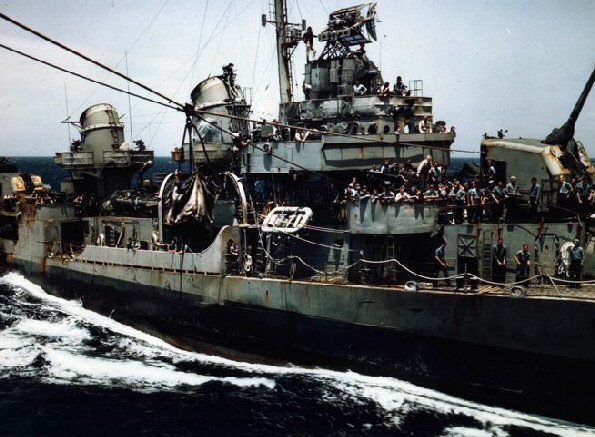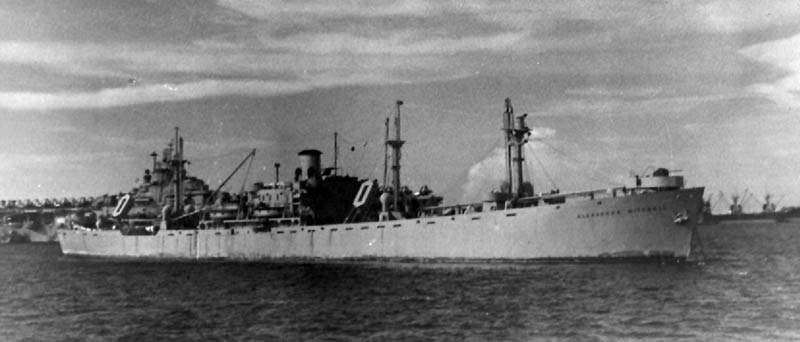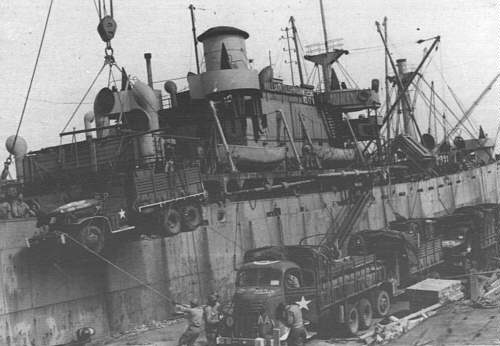
The 6th Bomb Group
Ships
|
|---|
The Merchant Marine ("The Forgotten Heroes of the War")
Tinian required constant supplies of men and materials. The harbor was Tinian's lifeline. At any time, several ships were unloading supplies in the harbor. It is hard to underestimate the bravery of the men of the Navy and merchant marine. They did not have the option of remaining in port in bad weather. Trips took several weeks and, more likely than not, they were somewhere in the middle of the ocean when bad weather struck. They carried heavy and dangerous cargos. Almost everything on Tinian, from bombs to bulldozers arrived by ship. They were in constant danger of enemy attack. Even near the end of the war, these trips could be dangerous, as evidenced by the experience of the USS Indianapolis was sunk late in the war after delivering atomic bomb parts to Tinian. The Merchant Marine was drafted into the service of the War Department and, as such, suffered greater casualty rates than most other branches of the service. Yet they did not receive recognition for this service until 1988, when they were finally given veteran status. |
|---|
The Liberty Ship
The Liberty Ship has been compared to the DC-3. It was a design from the 1930s, built in record numbers and remained in service for decades after the war. The United States built the Liberty Ship to help alleviate the shortage of ships. The ship was a classic "tramp steamer" design, modified to take advantage of new welding and modular construction techniques, and using an old technology steam engine. Unlike more sophisticated cargo ships, which took months to build, the Liberty ship was built in as little as 40 days. In all, 2710 Liberty Ships were built and they handled over 25% of the shipping in WWII. After the war, Liberty Ships remained in service for several decades and constituted 40% of the tramp steamer fleet in 1960. Only two of these ships remain - the Jeremiah O'Brien and the John W. Brown. |
|---|
|
The Liberty Ship had several unique characteristics. First, to insure that production began quickly, the ship was designed using a 1930s tramp steamer as a model. Second, to speed up construction, the design was modified to accommodate new welding techniques and modular design. Third, the ship used an older technology triple-expansion steam engine (first invented in 1873), rather than a modern diesel. The steam engine was easier to produce and the Liberty Ship only had to be as fast as the slowest ship in the convoy, around 10 knots. Fourth, the ship was designed as a "disposable" ship, with a useful life of only 5 years. Nevertheless, they remained in service for decades. Finally, and most unfortunately, the first Liberty Ships had a design flaw that led to the nickname of "Kaiser's coffins". Under certain conditions, the ship would literally break in half, just ahead of the cabin. Although the builders supposedly found and fixed this problem, some postwar pictures suggest that the fix was not perfect.
LIBERTY SHIP SPECIFICATIONS: |
Destroyers
Navy Destroyers played the biggest role in guarding the supply ship. These "Tin Cans" were much smaller than the ships they escorted, but were faster and more maneuverable. |
|---|
 A Fletcher-class Destroyer shows the wear and tear of long days at sea. |
Unlike the large capital ships (such as battleships, carriers and cruisers), the destroyers were designed for speed, not comfort. Like submariners, destroyermen were a special breed of sailors, recognizing that the warships they might encounter would often outgun them and that they would have to survive by their wits, rather than by raw firepower. |
|
FLETCHER CLASS DESTROYER SPECIFICATIONS: |


